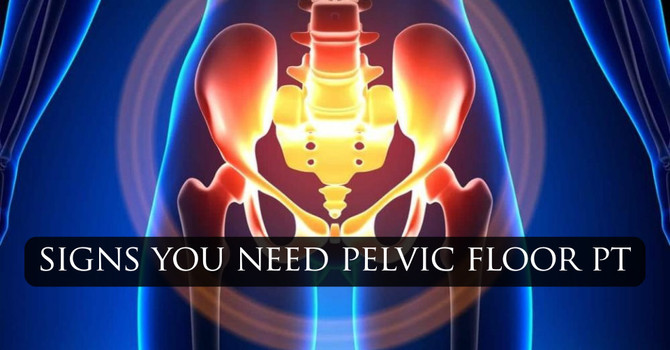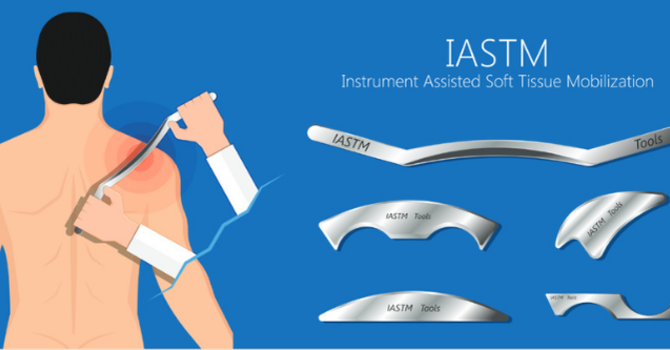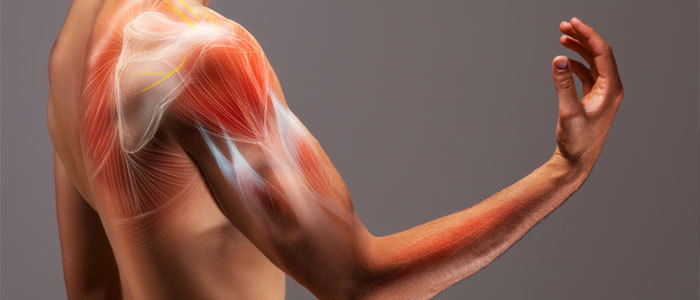
Have you ever felt a nagging pain in your lower back that won’t go away, or a constant tightness in your neck and shoulders? You might chalk it up to stress or a bad night’s sleep, but the real culprit could be a muscle imbalance. In simple terms, this happens when certain muscles in your body are working overtime while others have become weak and lazy.
This uneven pull on your skeleton can throw your whole body out of alignment. Over time, it forces your joints and other tissues to handle stress they weren't designed for, leading to chronic pain, stiffness, and recurring injuries. But there is a path to chronic pain relief. Understanding the root cause is the first step, and this guide will show you how to fix a muscle imbalance and reclaim your comfort.
The Science Behind Muscle Imbalances
Your body is designed to work as a balanced, synergistic system. Muscles often work in pairs: as one muscle contracts (the agonist), its opposing muscle relaxes (the antagonist). A perfect example is your bicep and tricep. When you bend your elbow, the bicep contracts and the tricep lengthens.
A muscle imbalance occurs when this partnership breaks down. Repetitive movements, poor posture, or injuries can cause certain muscles to become chronically tight and overactive. In response, their opposing muscles become lengthened and weak, or "inhibited." This creates a dysfunctional pattern that disrupts your body's natural mechanics, placing uneven stress on your joints, ligaments, and tendons.
For instance, sitting at a desk all day often leads to tight hip flexors and a weak, underactive gluteal complex. This common imbalance is a primary driver of low back pain for people across South Jersey.
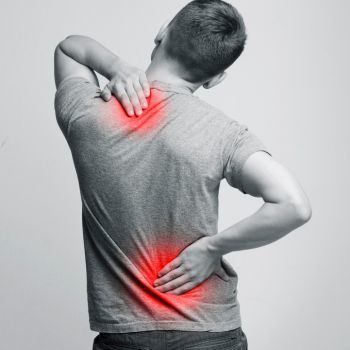
Common Causes and Risk Factors
Muscle imbalances don't just happen overnight. They develop from our daily habits and activities. Key causes include:
- Poor Posture: Slouching at your desk in or constantly looking down at your phone shortens chest muscles and weakens upper back muscles.
- Repetitive Movements: Performing the same motion repeatedly, whether in sports or at work, can overdevelop certain muscle groups while neglecting others.
- Sedentary Lifestyle: Prolonged sitting weakens major muscle groups, especially the glutes and core, which are essential for stability.
- Previous Injuries: After an injury, your body often compensates by changing how it moves, which can lead to new imbalances if not properly rehabilitated.
Symptoms of a Muscle Imbalance
How do you know if a muscle imbalance is the source of your pain? Look for these common signs:
- Pain in your lower back, neck, hips, or knees that doesn't have a clear cause.
- A feeling of stiffness or limited range of motion in certain joints.
- Noticing that one side of your body feels different or moves less efficiently than the other.
- Recurring injuries, such as repeatedly pulling the same muscle or spraining the same ankle.
How Imbalances Cause Chronic Pain
A balanced body distributes force evenly. When an imbalance is present, that force is concentrated on specific areas, leading to wear and tear.
- Low Back Pain: As mentioned, tight hip flexors and weak glutes can tilt the pelvis forward. This increases the curve in the lower back (lordosis), compressing the spinal joints and straining the surrounding muscles.
- Neck and Shoulder Pain: "Tech neck" from looking at screens causes the muscles in the front of the neck and chest to tighten, while the muscles in the upper back become weak. This pulls the head forward, placing immense strain on the cervical spine.
- Hip and Knee Pain: Weak gluteal muscles, particularly the gluteus medius, can cause the pelvis to drop during walking or running. This forces other muscles around the hip and knee to work harder, often leading to IT band syndrome or patellofemoral (runner's knee) pain.
How to Fix a Muscle Imbalance: Treatment Options
Fortunately, muscle imbalances are correctable, and many advanced approaches are available today to address both the symptoms and the underlying causes. At Optimal Health Chiropractic and Physical Therapy, we provide a highly collaborative, evidence-based experience that blends advanced chiropractic care with in-office physical therapy.
A fundamental aspect of our assessment is identifying specific muscle imbalances in both the upper and lower body. For example, in the upper body, it’s common to see tightness in muscles like the upper trapezius, levator scapulae, pec minor, and suboccipital muscles. These overactive muscles tend to lift and round the shoulders, contribute to anterior head posture, and place excessive pressure on the neck—often leading to pain, tension, and even headaches. Left unaddressed, this faulty muscle firing pattern puts increased stress on the joints and can result in chronic conditions like arthritis or nerve impingement.
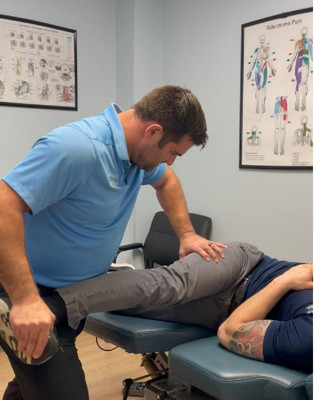
Restoring true balance isn’t just about releasing what’s tight—it’s about strengthening what’s weak. That’s why we focus on activating and developing the opposing muscle groups, such as the lower trapezius and serratus anterior. Strengthening these muscles helps bring the shoulders down, improves alignment, and supports a neutral neck position, relieving pressure and restoring healthy movement.
Chiropractic care for muscle imbalance offers a comprehensive and effective approach that integrates several powerful techniques. A modern, evidence-based chiropractor will go beyond simple adjustments to address the functional root of the problem. At our clinics in Egg Harbor Township and Washington Township, we focus on restoring proper movement patterns to provide lasting chronic pain relief. This can involve:
- Chiropractic Adjustments: Targeted adjustments restore mobility and optimal alignment in spinal and extremity joints, reducing compensation patterns and pain signals.
- Soft Tissue Therapy: Methods like Myofascial Release and Active Release Technique (ART) specifically target tight, overactive areas (such as the upper traps, pec minor, or suboccipital muscles), breaking down adhesions and relieving tension to improve tissue quality and movement.
- Graston Technique: This instrument-assisted soft tissue therapy uses specially designed stainless steel tools to detect and break down scar tissue and fascial restrictions, speeding up recovery and restoring full mobility in affected muscles.
- Dynamic Neuromuscular Stabilization (DNS): DNS retrains the body’s movement patterns and core stability by targeting the neuromuscular system. It restores optimal coordination among muscle groups for true long-term relief.
- Postural Advice: Practical, individualized guidance is provided to help undo the effects of daily habits contributing to poor posture and imbalances—whether it’s adjusting desk setup, mindful reminders to avoid shoulder shrugging, or cues to maintain a neutral head position.
Physical Therapy for Muscle Imbalance: In-office physical therapy is essential for functional rehabilitation and preventing reinjury. Our licensed PTs develop customized plans tailored to your exact needs, whether you’re a desk worker dealing with neck tightness or an athlete recovering from injury.
- The McKenzie Method: This active, exercise-based approach—backed by research—focuses on self-treatment strategies, centralizing pain and restoring range of motion, particularly useful for spinal complaints and chronic low back pain.
- Post-Isometric Relaxation and Muscle Energy Techniques: These hands-on therapies use gentle contractions and stretching to relax tight muscle groups and reestablish correct firing patterns.
- Corrective Exercise Programs: Highly individualized routines target weak or inhibited areas (like the lower traps or serratus anterior), enhancing mobility, balance, and strength to support long-term correction of imbalances and reduce the risk of recurrence.
By combining these evidence-based treatment options—including advanced soft tissue techniques, corrective exercises, and postural retraining—patients recover faster and achieve lasting chronic pain relief. Addressing both the overactive and underactive muscles not only resolves pain but also builds resilience, helping you move better, feel stronger, and prevent injury for the long run.
At-Home Tips for Preventing Imbalances
You can take proactive steps every day to correct and prevent muscle imbalances. Start by incorporating these simple habits and exercises into your routine.
Simple Posture Fixes and Stretches
- Doorway Pec Stretch: Stand in a doorway and place your forearms on the frame, with your elbows slightly below shoulder height. Step forward gently until you feel a stretch across your chest. Hold for 30 seconds. This helps open up a tight chest from slouching.
- Glute Bridge: Lie on your back with your knees bent and feet flat on the floor. Squeeze your glutes and lift your hips toward the ceiling until your body forms a straight line from your shoulders to your knees. Hold for a moment, then lower slowly. This activates weak glute muscles.
- Chin Tucks: Sit or stand tall. Gently tuck your chin toward your chest, creating a "double chin" feeling. You should feel a stretch at the back of your neck. This strengthens the deep neck flexors and corrects forward head posture.
- Regular Movement Breaks: If you have a desk job, set a timer to get up and walk around for a few minutes every hour. This prevents your hip flexors from becoming chronically tight.
Take Control of Your Chronic Pain Today
Living with chronic pain can be exhausting, but you don’t have to accept it as your new normal. By identifying and addressing the underlying muscle imbalances, you can restore your body's natural alignment and find lasting relief. A professional assessment is the safest and most effective way to get started.
For a deeper understanding, watch Dr. Rick’s video on muscle imbalances on YouTube, where he explains common patterns and how targeted approaches can help you move and feel better.
If you are tired of recurring pain and ready to find a real solution, schedule a posture and muscle balance assessment at Optimal Health Chiropractic and Physical Therapy. Our expert team is ready to create a personalized plan to help you move better, feel better, and live pain-free. Visit our clinics in Egg Harbor Township or Washington Township and start your journey to a balanced body.


